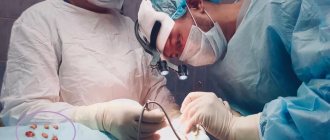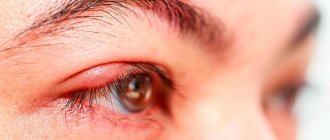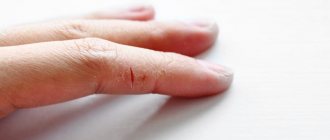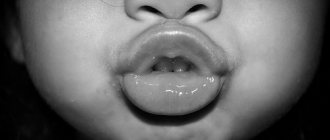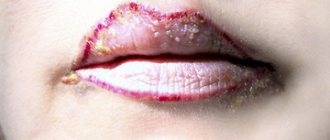The eyes itch and itch in a variety of ophthalmopathologies. Moreover, this symptom sometimes signals a systemic disease. In some cases, itching in the eyes is not dangerous when it is caused by exposure to external factors on the mucous membrane or cornea. Let's find out what causes itching in the eyes, the causes and methods of treating the disease.
Many ophthalmological diseases of a bacterial, infectious, inflammatory nature are accompanied by a symptom such as itching in the eyes. Sometimes it causes mechanical injury to the eyeball, contact with dust, cosmetics and other foreign bodies on the cornea or mucous membrane. Eyes can itch due to various systemic pathologies. Thus, there are three groups of reasons that are the culprits of this common symptom. Let's look at them in more detail and find out the signs of various eye pathologies that cause itchy eyes. This will make it easier to distinguish one disease from another and understand the cause of its occurrence.
Itching in the eyes: non-pathological causes
First, it’s worth listing factors that have nothing to do with diseases. They are usually associated with the external environment. These exogenous causes of itchy eyes include:
- wearing optics, spectacles and contacts, which are not selected correctly or are used in the wrong mode;
- contact with particles of dirt, dust, chemical compounds, and tobacco smoke on the outer surface of the eye;
- prolonged work at a computer monitor without breaks;
- prolonged stay in rooms where there is a lot of dust or the air is too dry;
- chronic lack of sleep;
- exposure of the eyes to a bright light source.
In order to eliminate itching in the eyes, it is necessary to protect them from the main irritant. In other words, it is necessary to work in ventilated areas; glasses and contact lenses should be selected only with an ophthalmologist, and not independently. While working at the computer, take breaks and do eye exercises to help relax your eye muscles. If a foreign body gets on the surface of the eyeball and does not injure the upper epithelial tissues, you just need to remove it from the eye with a handkerchief and water. All of the above reasons of an endogenous nature often do not lead to the development of diseases. Of course, if you wear incorrectly fitted glasses for a long time, your vision will most likely deteriorate even more. However, a single exposure to all these factors on the eyes does not pose a serious danger.
Prevention
- Regular hand washing. Many people have a habit of rubbing their eyes, so it is better to eliminate the risk of infection on the surface of the cornea in advance.
- Wearing sunglasses in sunny weather. They will protect the mucous membrane from exposure to ultraviolet radiation.
- Using computer glasses. They relieve eye strain when working at a computer.
- Regular warm-up. Improves eye well-being and helps them relax.
- Minimal contact with allergens.
What ophthalmic pathologies cause itchy eyes?
Eye diseases are the second group of causes that cause itching in the eyes. This symptom is characteristic of the following ophthalmological diseases:
- dry eye syndrome;
- blepharitis;
- conjunctivitis;
- eye allergies;
- trachoma;
- barley;
- demodicosis of the eyelids;
- glaucoma;
- cataract.
All these pathologies are quite serious and they take a long time to be treated.
Some of them can cause a severe decrease in visual functions, up to complete irreversible blindness. How to distinguish one disease from another? Should you panic if your eyes itch? To answer these questions, you need to know what other symptoms are accompanied by all these diseases.
Itching due to dry eye syndrome
The syndrome occurs when there is insufficient production of tear fluid. Nowadays, when electronic devices of various types are widespread, and the environmental situation is greatly deteriorating, dry eye syndrome is diagnosed in almost every fifth person. It can be treated quite simply with eye drops. However, even timely treatment cannot cure the disease forever. Having appeared once, it subsequently takes a latent form and, in the absence of prevention, recurs.
The surface of the eye should always be moisturized. It is covered with a protective film, the thickness of which does not exceed one tenth of a millimeter. The protective film breaks, but reappears as a result of blinking. With increased dryness in the eyes, ruptures occur more often than in a healthy person, and the film is not completely restored. Because of this, a person is bothered by the following symptoms:
- the presence of “sand” on the cornea and under the eyelids;
- itching, burning, pain in the eyes;
- increased lacrimation;
- rapid eye fatigue;
- blurred vision.
Symptoms are more likely to occur during visual stress.
Pathogenic causes
This group includes pathologies caused by weak immunity, allergies, bacterial or viral infections, and parasites.
Allergic reaction
The body's reaction to allergens that irritate the mucous membrane. It most often occurs in the spring, when plants begin to bloom and a huge amount of allergens enter the air. Because of them, the eyes begin to dry out and itch from the inside. Certain foods can cause a reaction: milk, eggs, chocolate, citrus fruits, pomegranates or strawberries.
Taking certain medications can also lead to allergy symptoms. These include antibiotics, vitamin complexes and preparations containing iodine. In women, allergies can be caused by incorrectly selected cosmetics.
Diagnosis of allergies is carried out using a series of laboratory tests that can pinpoint the cause of the discomfort. After this, the doctor selects antihistamines.
To prevent itching, you can wash your eyes with special drops several times a day. This reduces contact of the mucous membrane with allergens.
Conjunctivitis
Inflammation of the mucous membrane, which is based on an allergy or infection. The infectious form is usually caused by viruses or bacteria, very rarely by a fungus. The disease can be transmitted from person to person through contact.
With conjunctivitis, itching is the first sign that requires you to consult a doctor to select treatment. During therapy, local antiviral or antibacterial drugs are used in the form of eye drops or ointments.
Blepharitis
Inflammation of the eyelids caused by anemia, diseases of the digestive system, diabetes, infection and other pathologies. As blepharitis develops, the refractive function of the eyes deteriorates, causing concomitant pathologies, such as farsightedness, to appear. The patient has a desire to scratch his eyelids, swelling forms.
The disease is accompanied by the formation of small scales or ulcers along the edges of the eyelids. Treatment of blepharitis takes a long time and, in addition to getting rid of the symptoms, includes eliminating the causes of its development.
Demodicosis
Damage to the skin by the parasitic demodex mite. The activity of the parasite leads to itching from the inside, pain and itching of the eye. The main method of treatment involves the use of gels or ointments that reduce the activity of the parasite.
Dry eye syndrome
Causes dryness and swelling of the mucous membrane, itching. The patient feels as if sand has gotten under his eyelids, which is why he begins to rub his eyes frequently, aggravating the condition. The syndrome is caused by a lack of tear production.
Dry eye syndrome is usually experienced by older people; it occurs in them 65-70% more often than in younger patients. Recently, the problem has been encountered among office workers who spend a lot of time in front of a monitor screen in an office with dry air. The syndrome is also caused by chemical or thermal burns and adenoviruses.
Barley
Purulent inflammation of the sebaceous gland of the eyelid or eyelash follicle. Develops against a background of reduced immunity, severe hypothermia, and frequent stress.
The infection penetrates the gland or hair follicle, after which pus formation and inflammation begin. First, a small itchy dot appears on the edge of the eyelid, painful when touched. Gradually, the tissues around it swell, redness appears, and the head of an abscess forms. After opening it, pus and dead tissue are released.
To treat stye and reduce itching, the doctor selects antibacterial ointments and drops and prescribes therapy to strengthen the immune system.
What eye drops help with dry eye syndrome?
At the very beginning of the development of the disease, its symptoms, including itching in the eyes, can be eliminated with the help of drops that restore the tear film. In some cases, the use of bacterial drugs may be necessary. Consultation with an ophthalmologist when choosing any drops is required. The most famous drugs of the first type are:
- "Okutiarz." The drops contain components of natural human tears and sodium hyaluronate, which is similar to it in pH value. This drug quickly relieves itching, burning, eye fatigue and other signs of the syndrome. Drops should be instilled immediately when they appear.
- "Kationorm" - drops for itchy eyes and dryness, used in the morning. After sleep, the cornea may experience dryness, since the eyes are closed at night, therefore, oxygen access to them is slightly limited. The medicine instantly restores the tear film, which is why all the symptoms of the pathology disappear within a couple of minutes.
Both tear substitutes are preservative-free. They do not provoke allergies and have no side effects. You can bury them several times a day. However, this does not mean that it is safe to take them without first visiting an ophthalmologist's office. In addition, he may prescribe antibacterial drops, which will have to be instilled for at least 7 days.
Traditional medicine
You can also eliminate discomfort at home. There are a large number of recipes for restoring and renewing the skin. But be careful, you may be allergic to some ingredient. Be sure to do a test before using the product. Here are some of the most popular home remedy recipes:
Softening lotion
To relieve redness and prevent the infection from progressing, use lotion. It will make the skin restoration process faster, relieve itching, remove peeling, and improve intracellular processes. To prepare it you will need:
- still mineral water (100 ml);
- sea buckthorn oil (20 ml);
- salicylic acid (5 ml).
Fill a small cosmetic bottle with water, add salicylic acid and sea buckthorn oil. Shake the bottle well before use. Apply lotion to skin morning and evening. Before doing this, do not forget to cleanse your skin using special products.
Anti-irritation mask
A mask made from natural ingredients heals cracks, relieves itching, and has a softening effect on problem areas of the skin. You will need these ingredients:
- cucumber (1 pc.);
- aloe juice (1 tablespoon);
- sandalwood essential oil (2 drops).
Peel the cucumber and grate it. Mix the resulting pulp with aloe juice and sandalwood oil. Apply the mixture to your face and apply a damp cloth or napkin. Keep the mask on for about 30 minutes, then thoroughly cleanse your face. Repeat the procedure at least 3 times a week.
Mask to restore damaged skin
Redness and itching are often caused by sunburn. Over time, age spots and small wrinkles appear on the face. To avoid this, you should moisturize your skin regularly. The most popular and effective remedy is a mask. To prepare it at home, you will need:
- potatoes (1 pc.);
- sour cream (1 tablespoon);
- avocado oil (1 tablespoon).
Peel the potatoes, grate them or grind them in a blender. Mix potatoes with cold sour cream and avocado oil. Cleanse the skin, then spread the mask over the entire face (except for the eyelids and area around the mouth). After 20 minutes, rinse off the product. To prevent your skin from flaking, apply the mask daily for 7 days.
Itchy eyes and blepharitis
The eyes also itch due to inflammation affecting the edges of the eyelids. Blepharitis occurs due to pathogenic microorganisms entering the skin of the eyelids.
Sometimes it becomes a concomitant disease of any systemic pathology that weakens the immune system. There are two groups of blepharitis symptoms. The primary signs are:
- asthenopia;
- increased sensitivity of the eyes to wind, sun and other similar external irritants;
- redness, itching and swelling of the eyelids;
- blurred image;
- tear fluid formed in large quantities;
- purulent discharge, which leads to sticking of the eyelids in the morning.
If left untreated, symptoms worsen. Secondary signs of pathology appear that are associated with circulatory disorders:
- photophobia;
- diplopia;
- foamy discharge from the eyes;
- eyelash loss;
- formation of crusts on the edges of the eyelids.
Blepharitis is a group of ophthalmological diseases accompanied by inflammation of the edges of the eyelids. There are scaly, meimobia, allergic, acne types of this disease. Each of them is characterized by itching in the eyes.
Irritation on the face from cosmetics
When buying cosmetics, we all hope that they will bring us only benefit and beauty. But, alas, this is not always the case. Very often, instead of healthy, beautiful and moisturized skin, we get irritation, peeling and pimples on our face.
Poor quality or expired cosmetics, individual intolerance - causes of irritation on the face
It is very common to be allergic to decorative cosmetics - lipsticks, mascara, eye shadow, foundation, powder, etc. Here, both sensitivity to the components of the cosmetic product and mechanical blockage of skin pores play a role, which leads to inflammation and pimples.
Irritation from cosmetics can manifest itself in the form of:
- Peeling skin
- Skin redness
- Small pimples and pustules on the skin
- Itchy skin
To avoid allergies to cosmetic products, you should always conduct a sensitivity test; instructions for performing this test can be found in any insert for the cream or powder. Usually, it is suggested to apply a small amount of the product on the bend of the elbow, since the skin there is the most sensitive. If after 12 hours no redness, itching or rash appears, then you can use this remedy.
Do not use cosmetics from brands whose products have previously caused irritation.
You should also remember that you should not buy cosmetics from dubious companies, cheap products and fake brands. Always read the ingredients before using cosmetics, as they may contain additives to which you are hypersensitive or allergic.
If you do experience irritation from a cosmetic product, you should immediately remove it from the skin and wipe your face with a soothing hypoallergenic toner. You should no longer use this particular product or other cosmetic products from this manufacturer. It would also be a good idea to consult a doctor to select the right treatment.
Is blepharitis treated with drops for itchy eyes?
Treatment of blepharitis is conservative and takes a long time. The patient is prescribed medications in the form of eye drops, ointments and gels, physiotherapeutic procedures, and eye compresses. Often, with inflammation of the eyelids, the patient has to instill drops such as Ciprofloxacin and Ofloxacin into the eyes. They have an antimicrobial effect.
Blepharitis cannot be started. This disease quickly becomes chronic. Moreover, inflammation of the eyelids can lead to the development of other eye diseases: styes, keratitis, eyelid deformities, trichiasis.
Treatment of pathology
First of all, it is necessary to establish what the body reacts to so violently. And subsequently try to reduce contact as much as possible. For this purpose, you need to make an appointment with an allergist, who will conduct all the tests recommended in such cases.
After this, the doctor will draw up a medication regimen, which will need to be applied when the next attack develops.
Drug treatment
If symptoms appear rapidly, then injectable antihistamines may be prescribed. This could be Suprastin, Diphenhydramine or Tavegil.
Hormonal medications relieve allergic inflammation and redness well. Here you can use Dexamethasone, Hydrocortisone, Prednisolone. But we must remember that long-term regular use is strictly prohibited, since the drugs cause many adverse reactions.
If the allergy is mild and swelling as such does not bother the person much, then the doctor may recommend the following tablets - Erius, Loratadine, Claritin, etc.
If drug therapy does not provide the required therapeutic effect, then the hyposensitization method can be used. The essence of the treatment is very simple: a person receives microdoses of the allergen. The result of the event is the body’s adaptation and, as a result, a decrease or complete absence of an allergic reaction in the future.
If an allergy appears on your face and edematous inflammation develops, then you need to reconsider your diet somewhat. This must be done even if the allergy is not due to food. For example, eggs, nuts, chocolate, red fish, oranges and lemons can only increase inflammation and the accompanying itching and redness. You also need to limit the use of salt and increase the amount of fluid and fresh vegetables and fruits you consume.
Treatment with traditional methods
In addition to masks made from fermented milk, which relieves allergy symptoms, you can also use herbal infusions. Here you can take decoctions of burdock, dandelion or bear's ear root. Herbs have diuretic properties and help remove excess fluid from the body.
Cold compresses help relieve itching and swelling. You need to wrap pieces of ice in a soft cloth - flannel or knitwear - and apply to the inflamed area. The duration of the procedure is fifteen minutes.
For the same purpose, you can use fresh cucumber - juice or thin slices cut from the vegetable. An infusion of calendula inflorescences, as well as cold milk compresses, also help.
Relieves swelling and decoction of flaxseeds. To prepare it, you need to pour a large spoon of seeds with 100 grams of boiling water. Infuse, filter and can be used as a compress on the swollen area.
If allergies are accompanied by rashes, then you can use the following recipe: mix two tablespoons of birch tar, sulfur powder (3 grams) and 100 grams of melted lard. Heat the mixture in a water bath and let it harden. The ointment is applied to the inflamed areas before going to bed at night.
If the cause of the allergy is a lack of calcium, then it is recommended to take eggshell powder. Scheme – 1/3 of a small spoon after meals. You need to add a little lemon juice to it.
To relieve itching, you can use the following methods:
- treat the skin with an aqueous solution of soda;
- If an allergy has developed due to an insect bite, then fresh potatoes grated on a fine grater will help.
Conjunctivitis and itchy eyes: causes, treatment
Conjunctivitis is an inflammation of a polyetiological nature that spreads to the mucous membrane of the eye. By polyetiological nature we mean a plurality of reasons that can provoke it. Conjunctivitis is classified in many ways. It can be allergic, chronic, purulent, catarrhal, viral, fungal. Accordingly, the symptoms of this pathology are quite extensive. People suffering from conjunctivitis of any form may complain of:
- swelling, redness of the eyelids;
- discharge of pus and mucus from the eyes;
- burning, itching in the eyes;
- profuse lacrimation;
- a feeling of fear of bright light, causing blepharospasm;
- sticking together of eyelids in the morning;
- decreased visual acuity.
Some forms of inflammation of the eye mucosa are accompanied by headache, fever, cough, weakness, and muscle pain. Perhaps itching in the eyes is one of the symptoms that is typical for any conjunctivitis. Treatment of this disease is determined by its etiology. However, in all cases eye drops are used. If conjunctivitis has an allergic basis, anti-allergenic (Zyrtec) and antihistamine (Allergoftal) drugs are prescribed. The viral form of the disease is treated with antibacterial drops. Antiallergenic drugs are prescribed when swelling and irritation do not subside. If your eyes itch, drops help eliminate itching and prevent other microbes from entering the mucous membrane.
Some types of conjunctivitis cannot be completely cured. It takes a hidden form and does not bother a person until a certain time. This happens, for example, with allergic inflammations, which are seasonal. It is necessary to treat the pathology in each specific case in the early stages. If left untreated, it can lead to the development of blepharitis and scarring of the eyelids and cornea.
Eyelids are red, swollen and itchy: how to treat them
If the eyelid above the eye is swollen and itchy, you should not rub it. It is necessary to rinse the affected area with clean water or apply drops intended to relieve eye fatigue during prolonged work at the computer. Then be sure to consult an ophthalmologist.
Allergy treatment
You can eliminate itching, redness, and swelling of the eyes caused by external irritants on your own. It is enough to exclude it. You should analyze what new means have appeared in everyday life and not use them. To protect from the wind, you can wear glasses with simple lenses. They will not affect your vision, but will save you from red eyes and swelling of the eyelids.
If the allergen is identified and eliminated in a timely manner, the symptoms will not progress, but will not disappear in 1 day. Room temperature compresses made from herbal decoctions will help speed up the healing process. Pharmaceutical chamomile, plantain, and calendula are suitable. The product must be prepared according to the recipe indicated on the package. After the broth has cooled, dip cotton pads, squeeze lightly and apply to closed eyes for 10 minutes. The procedure should be carried out twice a day.
It is much more difficult if the eyelids swell and tears flow when plants bloom. In this case, the problem cannot be solved without medication. Usually the doctor prescribes tablets: Suprastin, Claritin, Opatanol drops, Olopatadine, Azelastine, Ketotifen.
You cannot self-medicate, because completely different diseases can have similar symptoms. The selection of the correct course of therapy may depend on factors such as: characteristics of the body, type of irritant, climate, time of year and other indicators.
Treatment of infectious diseases
- For conjunctivitis, the doctor prescribes treatment of the affected area of the eyelid with a solution of furatsilin, potassium permanganate, ointments Tetracycline, Erythromycin, drops Gentamicin, Ciploxidin. In case of complex disease, intramuscular antibiotics may be prescribed.
- Barley is treated with antibacterial drops: Tsipromed, Levomycetin, treatment with Hydrocortisone and Tetracycline ointments, cauterization of the growth with brilliant green or iodine in the absence of allergies.
- Treatment for blepharitis is long-term and depends on the underlying cause of the disease. In addition to the main treatment, Chloramphenicol ointment, Erythromycin, Gentamicin drops are prescribed. If treated incorrectly or if the doctor’s advice is ignored, the disease becomes chronic.
What to do if your eyelids are peeling and swollen for another reason
- Treatment of demodicosis is effective only in complex therapy: Pilocarpine, Phosphacol, Armin stimulate contraction of the eye muscles; Metronidazole kills parasites; Dexamethasone or Diphenhydramine relieve allergies; Ciprofloxacin, Dimexide are used to prevent secondary infection.
- If the lower or upper eyelid is swollen and red, and the area around the eyes is itching and flaking due to exacerbation of diseases of the internal organs, the severity of symptoms can only be reduced temporarily by making applications from decoctions of medicinal mixtures or a weak solution of potassium permanganate. To completely eliminate discomfort, the underlying disease must be treated.
- If wood or metal shavings or other foreign bodies get in, it must be eliminated. You can try to do this with drops that imitate tears. Often in these cases you have to contact an ophthalmologist.
The course of treatment is determined only by the doctor. Usually the duration is at least 2 weeks. During this time, you need to give up any decorative cosmetics and avoid eye fatigue.
In many cases, unpleasant discomfort can be avoided by following simple recommendations:
- protect your eyes from adverse weather conditions using glasses with regular lenses;
- take a break every half hour when working at the computer;
- do not touch your face with dirty hands;
- moisturize the mucous membrane with special drops that imitate natural tears;
- it is necessary to include more fruits and vegetables in the diet;
- drink at least 1.5 liters of water daily.
- To prevent recurrence of swelling and redness of the eyelids, Blefarogel should be used in courses.
Eye allergies: causes and treatment
Eye allergy is a fairly broad concept, and not just a specific disease. An allergic reaction may directly affect the structures of the eyeball or eyelids. Depending on this, there are many types of allergies that develop before the eyes. In most cases, irritants affect the connective membrane (conjunctiva). Therefore, eye allergies are often considered as one of the varieties of the previously described disease - conjunctivitis. Its treatment is based on the use of ophthalmic drops. There are several types of medications prescribed when an allergic reaction develops in the eyes:
- antiallergic drops (“Allergodil”), which reduce the effect of allergens on the eyes;
- membrane stabilizing agents (Opticorm, Cromohexal), which prevent the release of histamine, which provokes irritation and other allergy symptoms;
- relieving itching (“Vizin”, “Octilia”, “Naphthyzin”), which are prescribed if the eyes itch. These drugs quickly relieve itching, swelling, and redness.
The most important thing for allergies is to eliminate contact with the irritant. If it is unknown, drops help cope with the signs of the disease. It can only be cured when the allergen is known.
Allergy
If your under eye is red and swollen, and in addition there are other symptoms that we will talk about now, then the reason may lie in an allergic reaction.
Other associated symptoms:
- pain in the eyes, itching sensations,
- photophobia,
- redness of the whites of the eyes,
- nasal congestion, sneezing, runny nose.
In this case, allergic swelling of the eye can be caused by any of a variety of allergens:
- cosmetics (or some component of a product),
- chlorine in water,
- lenses for contact vision correction,
- food (both internally and as part of traditional medicine recipes - that’s why natural is not always safe).
Observe when your eye is swollen and itchy to at least approximately identify the allergen.
If, when contact with a “suspicious” substance is avoided, the swelling subsides, then this was the cause. Allergic swelling goes away quite quickly, and upon repeated contact with the component that provoked it, it returns.
In this case, you should definitely consult a doctor and avoid as much as possible any contact with allergens, and also, possibly (if a specialist prescribes), use Suprastin, Loratadine, Cetrin, Zyrtec, Zodak or other drugs with antihistamine action.
When cases are particularly severe, corticosteroid ointments and creams are prescribed.
Trachoma and itching in the eyes: causes, treatment
Trachoma is an infectious disease caused by chlamydia. When they get into the eyes, they affect the connective and corneal membranes. The pathology is chronic. Initially it develops quite slowly. The patient's eyes become red, watery and itchy. Scar tissue may subsequently form. If you start treating the disease on time, it will not cause much harm. However, this disease has one peculiarity. At some point, it can turn into a progressive form, and this is fraught with severe deterioration in vision, up to its complete loss.
Bacteria from the chlamydia family, once in a living organism, begin to parasitize inside its cells. Such infections are transmitted through contact and household contact. A person can accidentally transfer bacteria to the mucous membrane of the eye with dirty hands. Doctors do not rule out the possibility that these microbes are carried by insects, such as flies. Chlamydia can be in the body without showing its presence in any way until favorable conditions for this occur. When a person is sick, his immune system is vulnerable and bacteria begin to attack. Even after the infection is cured, the body does not become protected from it, since it does not develop immunity against these microorganisms. The likelihood of relapse is very high.
What symptoms, besides itching in the eyes, are there with trachoma?
The three main signs of the disease have already been named: redness of the eyes, itching, watery eyes. The patient also develops photophobia. Staying in the sun without glasses or in rooms with bright light brings severe discomfort. The tissue on the cornea and conjunctiva becomes denser. On the connective membrane, follicles are formed - small bubbles that increase in size and burst, resulting in the formation of scars. Because of this, vision is rapidly declining. Pathology develops faster if a person suffers from another disease: tuberculosis, malaria.
Trachoma is treated on an inpatient or outpatient basis, depending on the stage. On the first and second follicles, they are removed using tweezers. The third and fourth stages are treated inpatiently. The patient has to stay in the infectious diseases department of the hospital. For trachoma, antibacterial agents and sulfonamides are prescribed - antimicrobial agents. If trachoma causes the eyelid to turn in, plastic surgery may be required. Sometimes it becomes necessary to transplant conjunctival tissue from the oral cavity.
Lack of treatment inevitably leads to vision deterioration. The patient's eyelashes may also stop growing. In severe forms of trachoma, ulcers appear on the cornea. The eyelids can roll inside the eye - entropion develops. All this greatly affects visual abilities. If the course of the disease is unfavorable, it is possible that the patient will go blind.
Stye on the eye - what drops relieve itching?
Stye, called hordeolum in ophthalmology, is an inflammation of the hair follicles of the eyelashes, meibomian glands or Zeiss sebaceous gland. The hair follicles and sebaceous glands of Zeiss are located outside the eyelid, and the meibomian gland is located inside. Barley is divided into internal and external according to localization. It develops after staphylococcus hits the specified structures of the eyelid. A healthy person with a strong immune system may not be afraid of developing the disease. The body will cope with the microbe. In order for bacteria to spread, appropriate conditions are needed. In case of hypothermia, the presence of diseases, or during periods of stress, the immune system is more vulnerable. This becomes the conditions for the development of infection, which leads to the onset of the inflammatory process. After this, the abscess begins to mature.
At about 2-4 days, the connective tissue of the eye turns red, a seal forms on the edge of the eyelid, in which you can see the yellowish contents. Several abscesses may also form. On the 3-4th day, that is, after the barley has fully ripened, the purulent seals break through. The patient's condition immediately improves noticeably. Often barley resolves quickly. However, in some cases it develops into a more complex form, becoming a chalazion, which may not go away for several months. Then it has to be removed promptly.
The primary signs of stye are itching, pain at the site of the abscess formation, lacrimation, and swelling of the eyelids. The swelling may be such that the eye closes completely and falls out of the visual process. Severe disease is accompanied by increased body temperature, weakness, malaise, nausea and lack of appetite, headaches, and swollen lymph nodes.
As soon as stye appears on the eyelid, it is necessary to treat it with antiseptic agents. After opening the abscess, antibacterial drops and ointments are prescribed. Typically, drugs such as Levomycetin, Floxal, and Tsipromed are used. It rarely comes to surgical treatment. During the operation, the abscess is opened, its contents are removed, and an antibacterial ointment is applied to the affected area of the eyelid.
Demodicosis of the eyelids - what is this disease and how is it treated?
Demodicosis in some classifications is considered as one of the varieties of blepharitis, when it becomes the result of a mite of the genus Demodex, the glandular acne, getting under the skin of the eyelids. Getting under the skin of the eyelids into the sebaceous glands or eyelash follicles, the mite parasitizes and feeds on dead skin cells. This parasite belongs to the group of opportunistic microorganisms. This means that it can be present in the body for a long time without manifesting itself. As soon as a person has a slight cold or hypothermia, the acne worm begins to attack. The eyelid affected by the parasite begins to become inflamed. Quite often, the inflammatory process covers not only the eyelids, but also the mucous membrane of the eye. The patient's eyes itch, the eyelids swell, the eyelashes fall out, a purulent crust forms along the edge of the eyelid, and the skin in this area peels off. A stye may also appear. As the disease progresses, the above symptoms are accompanied by photophobia, tearfulness, yellow secretion, and the formation of blisters with pus in the area of the eyelash bulbs. The mite secretes substances that are allergens. This causes the skin around the eye to break out in a rash.
Treatment of the disease
In case of allergies, redness of the skin under the eyes disappears after identifying the allergen. In this case, it must be eliminated from the patient’s routine. If you have allergies, you can take antihistamines, corticosteroids, or a variety of creams.
Treatment will be prescribed by a dermatologist or allergist after a thorough examination. To treat allergic rhinitis, mast cell membrane stabilizers and anticholinergic drugs are prescribed, since during rhinitis many chemical compounds together with histamine enter the bloodstream. This leads to a negative process.
To avoid inflammation after exposure to cold or heat, you should carefully protect the skin around the eyes with a scarf, hood or sunglasses, depending on the weather.
- For dermatitis, the skin around the eyes is thoroughly moisturized with creams containing a mixture of zinc and antibiotics. Many of them additionally relieve inflammation, discomfort and dryness. For this disease, corticosteroid ointments are contraindicated.
- Rosacea must be treated under the supervision of doctors, since the components of treatment include antibiotics, immunomodulators and creams with zinc oxide.
- In case of blepharitis, the patient should contact an ophthalmologist, who will prescribe a series of tests and additional studies. The therapy will be long-term. It consists of a complex of various ointments, antibiotics and antihistamines.
The most popular drops used to treat allergies
Hygiene of the eyelids and area under the eye plays an important role. The attending physician must demonstrate how to properly remove scales and crusts and the process of treating the affected area. Additionally, eyelid massage and diet are prescribed for the duration of therapy.
Conjunctivitis is a contagious disease, so it is important to carefully follow all hygiene rules and be sure to have individual toiletries. Irritation around the eyes can be relieved with various antihistamines in the form of tablets, ointments or syrups for children
In more advanced cases of the disease, steroid drops help, but they cause significant harm to the entire body and often cause dry mucous membranes. Their use should be minimal.
In allergic conjunctivitis, often due to swelling
In children, such redness can be caused by dry eye syndrome. It manifests itself during the first days of school. During this period, the eye often itches, since the child, who is not accustomed to heavy loads, is forced to constantly write, read and strain his eyesight.
In addition, while working at the blackboard, chalk dust often gets into your eyes. You need to teach your child to touch his face less, especially with dirty hands. - an unpleasant sign, so it’s worth finding out all the preventive measures.
https://youtube.com/watch?v=rliRgiEsmMg
Is demodicosis treated with drops?
This condition causes pain in the eyelids, so eye drops are not usually used. Even if a doctor prescribes antibacterial drugs in drops, they are not dropped into the eyes, but rather applied to the affected area of the skin and rubbed into it. However, in some cases, your doctor may prescribe eye drops for itchy eyes to be instilled into the conjunctival sac. This need arises when there is very strong itching and burning, which forces a person to rub their eyelids. To relieve these symptoms, a prescription is written for Dexamethasone, Okumetil, and Acular.
In severe forms of the pathology, when inflammation covers the mucous membrane and other structures of the eyeball, other drugs for instillation are prescribed: Levofloxacin, Tobrex, Dex-Gentamicin. They have an antibacterial effect. Drops have to be dripped from 7 to 10 days. Even after the disease is completely cured, the mite remains in the body. It can again become a source of infection, so it is important to prevent this pathology.
How to fix this problem?
The first thing you need to remember is that you need to be treated comprehensively! The result will be quick and effective.
Let's act on the reason:
- For simple dermatitis, we eliminate contact with the irritant and change the products we used. In case of allergic dermatitis, we eliminate the allergen, purchase antihistamines (Suprastin, Tavegil), calcium gluconate, in case of severe reactions, hormonal agents - dexamethasone, hydrocortisone, prednisolone, topical hormonal ointments.
- For dry skin, we use water-based moisturizers and oil-based cosmetics.
- If your face is red and itchy in the sun, use protective creams with a UV filter. In summer, moisturize your skin, in winter, cover it with a scarf, use nourishing creams. Limit trips to saunas and steam baths.
- For demodicosis, drugs are prescribed to improve the immune system, drugs that normalize the gastrointestinal tract, antiparasitic drugs, topical antibacterial, sulfur, and mercury ointments. Psoriasis is treated systemically - cyclosporine, roaccutane, sedatives, locally - salicylic, naphthalan ointment, physical methods - phototherapy. They use baths based on herbs and oils, and traditional medicine - infusions and teas of motherwort, chamomile, and mint. Treatment of seborrhea - sodium thiosulfate, calcium preparations, hormones, antibacterial ointments and creams, alcohol solutions. For fungal diseases - antifungal agents. At the same time, do not forget about diet and vitamins.
- If itching, redness and peeling of the face appear as a result of a disease of the internal organs, then we try to cure the underlying disease as much as possible.
- For mental disorders - consultation with a psychologist or psychiatrist, taking sedatives - ranging from herbs (mint, motherwort, valerian) to taking medications - Glitsed, Afobazol. Try to avoid stress, take B vitamins with magnesium (Magne - B6, for example).
- If redness and itching of the face occurs as a result of an insect bite, you can make a lotion with soda or tincture of calendula and chamomile. If the body's reaction to the bite is severe, you should take antihistamines.
Universal recommendations when the skin on the face itches:
Watch and choose the right cosmetics for your skin type, use high-quality products. Remember that various chemicals, preservatives and dyes are added to cosmetics, which also harm the skin, so try to limit their use. Do not get carried away with peeling; with frequent procedures, the skin does not have time to fully recover and the face begins to itch, redden and itch. Be sure to forget about bad habits and start watching your diet! In moderation – confectionery, citrus fruits. Try not to eat fried, spicy, smoked, fast food, soda, or coffee. Drink clean water up to 2 liters per day, eat vegetables and fruits. Take multivitamin complexes. When the face becomes red and itchy, the affected areas can be lubricated with vitamin A, E (carefully open the capsule before the procedure). You should not use medications without consulting a doctor, especially uncontrolled
Follow their dose, duration and regimen, remember the side effects (itching and redness, including). Try to spend more time outdoors, ventilate the room before going to bed to saturate your skin with oxygen. It is important to know that you should absolutely not comb the affected areas of the skin or rip off scabs; the damaged tissue can become infected! If the skin is peeling, you need to exfoliate once (at home in the form of a mask made of clay or coffee grounds), and then apply nourishing products. Physiotherapy, spa treatment, and balneotherapy work well.
Folk remedies when the face is very itchy and flaky:
- Oatmeal mask (1 tablespoon of cereal plus 50 ml of water) with the addition of vitamins A, E. Apply for 10-15 minutes, rinse. A mask with aloe juice and yeast based perfectly relieves redness.
- Lotions from herbal infusion: 2 tbsp. l. chamomile, string, nettle, parsley, oak bark, coltsfoot, pour 1 glass of boiling water, let it brew for about an hour.
- Potatoes (cut raw and apply to the area that is itchy and itchy).
- Fresh cucumber (puree and apply to skin).
Itching is not only an aesthetic problem, but can also be a symptom of a disease; for this, it is better and more reliable to make an appointment with a doctor, do a series of tests, find out the cause and eliminate the discomfort.
Glaucoma and itchy eyes
An ophthalmic disease characterized by increased pressure in the eyes is called glaucoma. It occurs mainly in old age and a variety of factors contribute to its development: genetic predisposition, unhealthy lifestyle, refractive errors, in particular farsightedness, eye injuries and others. Glaucoma takes different forms. It can be open-angle or closed-angle. The pressure in the eyes can be chronically elevated or paroxysmal. In any case, its increase causes severe discomfort to the patient. His eyes and head hurt, and the pain spreads to the eyeballs, brow ridges, and temples. This happens due to a violation of the outflow of intraocular fluid. It puts pressure on the walls of the eye and provokes a surge in pressure. This can lead to very unpleasant consequences. The ocular structures, including the optic disc, begin to literally collapse under the pressure of aqueous humor. For this reason, atrophy of the nerve occurs, which performs one of the main functions in vision - it transmits images received on the retina to the brain. Atrophy cannot be treated; fibers that are already damaged cannot be restored. This means that visual functions lost due to atrophic damage to the eye cannot be restored either. This may result in irreversible blindness.
Glaucoma is accompanied by a symptom such as itching in the eyes. It is strictly forbidden to scratch them. First of all, it doesn't bring relief. Secondly, there is a risk of infections in the organs of vision. Glaucoma against the background of diseases of infectious etiology is even more severe. To relieve itching, you can use compresses made from herbal infusions. Before using them, you should consult your doctor. Glaucoma does not tolerate self-medication. Incorrectly selected remedies can dramatically worsen the situation.
What drops are used to treat eyes with glaucoma?
For glaucomatous processes in the eyes, several groups of drugs are prescribed, each of which is aimed at different symptoms of the disease. Commonly used medications include the following solutions:
- "Timolol", "Ocumed", "Arutimol". They improve the outflow of aqueous humor.
- “Brinzolamide”, “Trusopt”, “Azopt”, which quickly lower blood pressure by about 20%.
- “Brimonidine”, “Clonidine”, which help reduce the production of intraocular fluid, thereby reducing its pressure on the walls of the chambers of the eye.
- “Xalacom”, “Azarga”, “Fotil” are combination drugs used for severe forms of glaucoma. Drops eliminate almost all symptoms of pathology.
The initial stages of this disease are treated conservatively. Complex forms require surgery, otherwise vision will be lost forever.
Itchy eyes due to cataracts
With cataracts, the lens responsible for focusing at different distances becomes cloudy. Consequently, with this disease, visual acuity decreases and other visual functions deteriorate. Cataracts develop most often in the elderly. Usually people who are diagnosed with it have a hereditary predisposition to it. Predisposing factors to the development of pathology are alcohol abuse, smoking, unbalanced diet, myopia, hypertension and other ailments. Itchy eyes are not a typical symptom of cataracts. First of all, vision suffers. Photosensitivity also develops, spots, sparks, flashes flash before the patient’s eyes, the image doubles, its contrast drops, and whitish spots appear around the perimeter of the pupil. Due to a decrease in visual acuity, a person’s eyes, especially if he constantly loads them with visual work, get tired very quickly. This symptom is already accompanied by burning and itching in the eyes.
Cataracts are treated in various ways. In the final stages, when the lens can no longer be saved, it is removed and an intraocular lens is installed in its place. Early stages of the disease can be cured or at least its progression can be stopped with drug therapy. The patient is prescribed eye drops (Vicein, Taufon, Vitafacol) and vitamins in the form of solutions for instillation (solutions of ascorbic, nicotinic acid, riboflavin).
All these diseases cause itchy eyes. This symptom is eliminated mainly with drops. It is possible to get rid of it completely, and not temporarily stop it, only by treating the underlying pathology. In this regard, it is not recommended to purchase eye drops yourself for itching in the eyes when they itch. It is unlikely that you will be able to accurately determine the cause of the itching, and therefore, choose the right medicine. Let's consider another group of factors that cause burning in the eyes and itching.
How to deal with peeling skin around the eyes
You can remove redness and flaking using moisturizing creams or folk remedies. Changing decorative and skincare cosmetics, a fortified diet and the “correct” consumption of water can also help. But if the reasons are not external, but internal, the problem will arise again.
So, the basic principles regarding proper care of the skin around the eyes are:
- Regularly perform masks from fresh fruits and vegetables, among which special preference should be given to cucumbers, tomatoes, bananas, and lemon. These products not only eliminate and prevent flaking of the skin under the eyes, but also refresh it, making it more elastic and rosy.
- Rubbing the skin with ice cubes.
- Cleansing the epidermis with scrubs.
- Using soft cleansers (gels, cream soaps).
- Avoiding the use of antibacterial soaps, which dry out the skin, causing the skin to peel and peel before the eyes.
- Frequent walks in the fresh air.
- Drinking enough fluid to replenish the water balance of the epidermis.
- Careful monitoring to ensure that the immune system fully copes with its functions. If the skin under the eyes is peeling due to weakened immunity, it is imperative to address this problem.
- Fight against vitamin deficiency.
If inflammation of the skin around the eyes causes a lot of discomfort, you can try to relieve it with medicinal lotions or wiping with ice. So, decoctions for these procedures should be prepared from medicinal plants such as:
- Pharmaceutical camomile. It has an antiseptic, sedative and analgesic effect.
- Calendula (marigold flowers) is a medicinal plant that has antiseptic, bactericidal, and anti-inflammatory effects.
- St. John's wort.
- Peppermint. This medicinal plant refreshes the skin and gives a feeling of coolness, which the epidermis especially needs during various pathological processes occurring in it.
- A series that has anti-allergic, relieving irritation, itching and inflammation effects.
To prepare a decoction, you need to take 5-6 g of the selected dry medicinal herb, pour boiling water over it and put on fire. After 6-7 minutes, remove the mixture from the stove, cool, then squeeze out the cake and filter through a sieve or cheesecloth.
Soak a cotton swab or clean soft cloth in the prepared broth, then apply to the sore spots. This medicine perfectly relieves inflammation and peeling of the skin on the eyelids and around them.
In addition to lotions, such a decoction can be frozen by forming ice cubes from it. They can be used for rubbing, which show excellent results if the skin near the eye is peeling.
In addition to this means of combating dermatological problems, you can resort to using another highly effective method - a compress of finely chopped fresh parsley leaves. Apply the paste to problem areas, hold for a quarter of an hour, then carefully remove with a cotton pad soaked in warm water.
If these procedures do not help, and the skin under the eyes still peels, what should you do in this case? First of all, stop panicking and seek help from a doctor. In this case, you don’t need to worry, but act, so don’t hesitate
It is especially important to consult a qualified specialist if the reason why the skin around the eyes is peeling has not been established.
Be sure to review your makeup bag. Perhaps it is in it that you will find the thing that became the culprit of all your troubles. If the problem actually lies in a weak immune system, be sure to undergo a course of therapy with immunomodulators.
This can be a tablet drug Ismizhen, herbal drops Sinupret or Imupret, homeopathic remedy Aflubin, etc. The course of treatment should last at least 3 weeks.
If, during this period of time, or after the end of therapy, the skin in the corner of one or both eyes does not stop peeling, it means that the cause of this anomaly was determined incorrectly.
Vitamin deficiency is another serious problem that must be combated in every possible way. What to do if the skin around the eyes peels precisely because of this anomaly? The answer is obvious: get rid of the problem immediately! To combat it, various vitamin complexes are suitable, as well as a menu enriched with cereals from different types of cereals, vegetables, herbs, fruits and nuts.
What systemic diseases cause itchy eyes?
In some diseases of a systemic nature, itching and burning may also appear in the eyes. Most often, this sign is also accompanied by redness of the scleral membrane. Itchy eyes occur in the following pathologies and conditions:
- diabetes;
- diseases of the gastrointestinal tract;
- hormonal imbalances;
- hypertension.
When the eyes itch due to ophthalmological ailments, lacrimation, diplopia, decreased quality of vision and many other signs are observed. In case of systemic diseases, the patient is concerned about symptoms such as:
- high blood pressure;
- constant thirst and swelling due to drinking too much;
- vomiting, nausea, abdominal pain;
- low-grade body temperature;
- frequent headaches, dizziness;
- a sharp decrease in body weight or weight gain without any objective prerequisites;
- rash;
- runny nose and others.
In these cases, treatment will also be aimed at the underlying pathology. The accompanying symptoms will disappear automatically after treatment.
What examinations are performed for itchy eyes?
If your eyes itch very often and the itching does not go away, you should first consult an ophthalmologist to rule out ophthalmological diseases or confirm one of them. In cases where the initial examination does not produce any results, computer methods of examining the visual organs are prescribed.
With such an ambiguous symptom, a comprehensive examination is often required. In order to accurately make a diagnosis, consultation with a gastroenterologist, endocrinologist, allergist and other specialists may be required. The patient will have to donate blood for clinical testing and allergy testing. The eyelids are also scraped for bacteriological analysis, and eyelashes are examined under a microscope. The treatment program can be adjusted depending on test results and the overall clinical picture of the disease.
If we talk about prevention, then it is impossible to foresee so many diseases. It is important to lead a healthy lifestyle, that is, eat right, exercise, and give up bad habits. People whose professional activities involve visual stress should do eye exercises daily. Get examined more often and visit the ophthalmologist's office. Even if these measures are not sufficient to prevent the disease, you will detect it in time and begin treatment.
MagazinLinz.ru team
Non-inflammatory peeling of the upper or lower eyelid
The following signs indicate the non-inflammatory nature of eyelid edema:
- increased pallor, sometimes even blueness of the face;
- the tissues are pale, the temperature is not elevated;
- swelling develops in both eyes;
- The swelling is most pronounced in the morning and gradually subsides during the day, although it does not always disappear completely.
Important! As with edema of an inflammatory nature, this type is accompanied by ascites and swelling of the legs. Morning swelling of the eyelids appears systematically or occasionally
Morning swelling of the eyelids appears systematically or occasionally.
The occurrence indicates violations of the diet and drinking regime, the use of inappropriate cosmetics, an unhealthy lifestyle, and frequent night work.
After eliminating the main cause, such swelling goes away on its own, without the use of special means.
A cold compress on the eyelids and lymphatic drainage massage help get rid of swelling quickly.
If your eyes are swollen and itchy constantly
If morning swelling has already become a constant phenomenon, this indicates illness:
- cardiovascular system;
- endocrine, digestive, urinary systems.
An examination is required to identify the underlying disease and prescribe treatment. To eliminate swelling and itching of the eyes, diuretics (Torasemide, Furasemide, Ethacrynic acid) are prescribed.
When a patient complains of non-inflammatory edema, the doctor focuses on identifying the cause. Often swollen and itchy eyes indicate the patient's abuse of drinks, spicy and salty foods. But sometimes swelling is a symptom of a tumor, in particular squamous cell carcinoma. Even if the cause seems obvious, the exact diagnosis will be determined only by a specialist.

